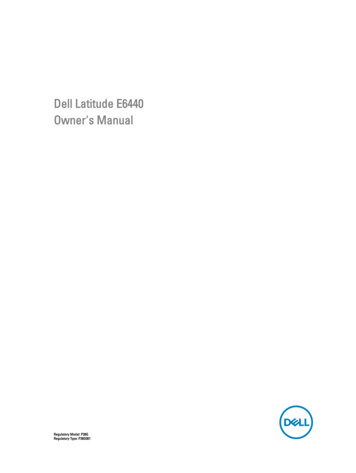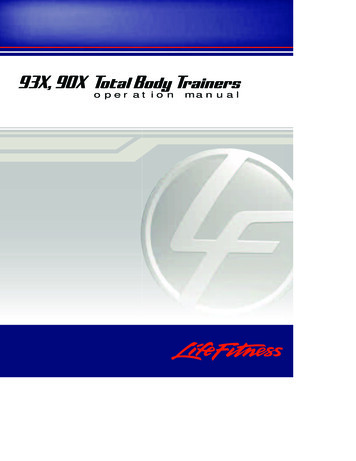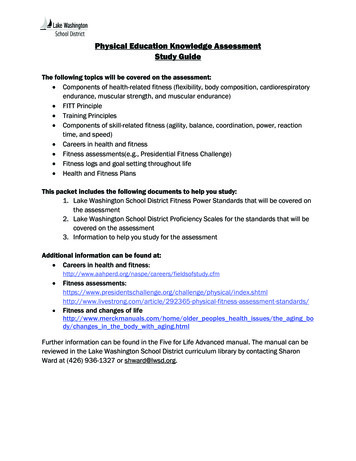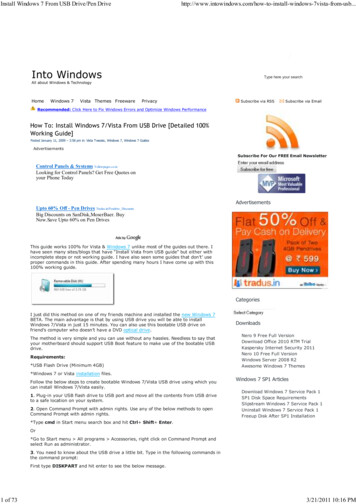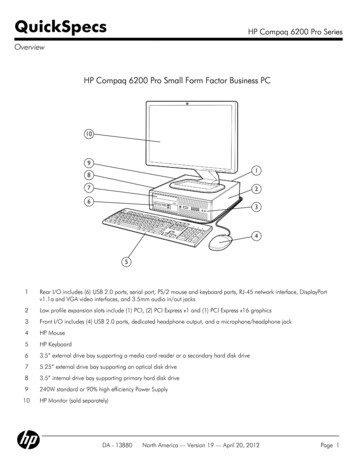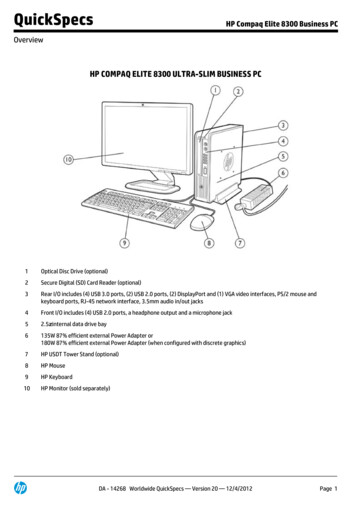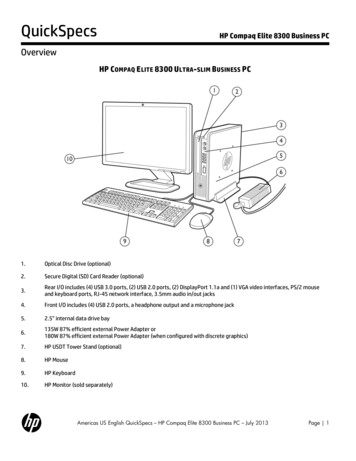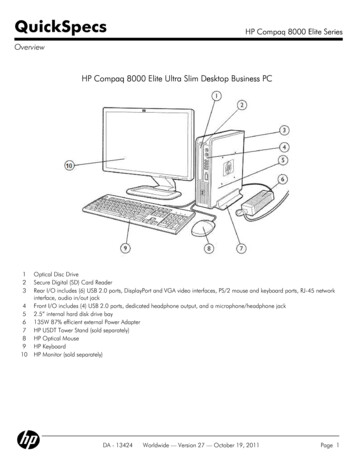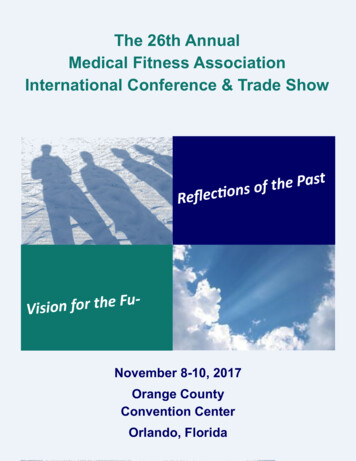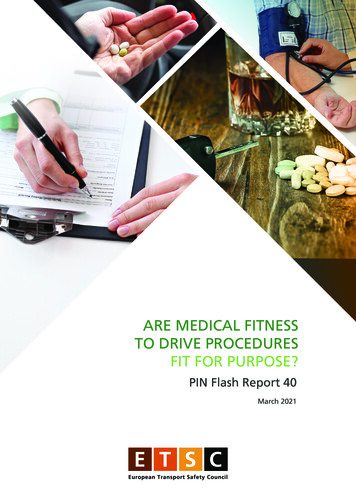
Transcription
ARE MEDICAL FITNESSTO DRIVE PROCEDURESFIT FOR PURPOSE?PIN Flash Report 40March 2021
PIN PanelPIN Steering GroupAustria (AT)Belgium (BE)Bulgaria (BG)Henk Stipdonk, Netherlands Institute for TransportPolicy Analysis (KiM) (PIN Co-chair)Klaus Machata, Road Safety Board (KFV)Stijn Daniels, VIAS instituteAleksi Kesyakov, Atanas Mitev, State-PublicConsultative Commission on Road SafetyCroatia (HR)Sanja Veić, Ministry of InteriorCzech Republic (CZ) Jiří Ambros, Jindřich Frič, Transport ResearchCentre (CDV)Cyprus (CY)George Morfakis, Road Safety ExpertAlexis Avgoustis, Ministry of TransportDenmark (DK)Pernille Ehlers, Danish Road Safety CouncilEstonia (EE)Maria Pashkevich, Road AdministrationFinland (FI)Esa Räty, Finnish Crash Data Institute (OTI)France (FR)Malo Quancard, Manuelle Salathé, NationalInterministerial Road Safety ObservatoryGermany (DE)Jacqueline Lacroix, German Road SafetyCouncil (DVR)Greece (EL)George Yannis, Technical University of AthensHungary (HU)Gábor Pauer, Road Safety Research Centre (KTI)Ireland (IE)Ben Breen, Sharon Heffernan, Velma Burns,Road Safety Authority (RSA)Israel (IL)Sarit Amram Katz, Dr. Assaf Sharon, RoadSafety AuthorityItaly (IT)Valentino Iurato, Ministry of TransportLatvia (LV)Aldis Lāma, Road Traffic Safety DirectorateLithuania (LT)Vidmantas Pumputis, Ministry of TransportLuxembourg (LU)Claude Paquet, Ministry for Mobility andPublic WorksMalta (MT)Patrick Cachia Marsh, Transport MaltaNetherlands (NL)Peter Mak, Ministry of TransportNorway (NO)Alena Høye, Institute of Transport Economics(TOI)Poland (PL)Dagmara Jankowska-Karpa, Motor TransportInstitute (ITS)Portugal (PT)João Cardoso, National Laboratory of CivilEngineering (LNEC)Romania (RO)Florentin Brăcea, Romanian National PoliceSerbia (RS)Lidija Stanojević, Road Traffic Safety AgencySlovakia (SK)Roman Török, Ministry of TransportSlovenia (SI)Andraz Murkovic, Traffic Safety AgencySpain (ES)Cristina Rodenas, Ministry of InteriorSweden (SE)Anna Vadeby, National Road and TransportResearch Institute (VTI)Switzerland (CH)Yvonne Achermann, Swiss Council forAccident Prevention (BFU)U.K. (GB)Alex Ma, Department for TransportMark Bell, Transport Research Laboratory (TRL)PIN ObserversStelios Efstathiadis, Road Safety Institute Panos Mylonas, GreeceLucia Pennisi, Automobile Club d’Italia (ACI), ItalyHeather Ward, University College London (UCL),(PIN Co-chair)Richard Allsop, ETSC Board of Directors (PINAdvisor)Letty Aarts, Institute for Road Safety Research(SWOV)Lars Ekman, Swedish Transport AdministrationEduard Fernández, CITAJacqueline Lacroix, German Road Safety Council(DVR)Astrid Linder, National Road and TransportResearch Institute (VTI)Wiebke Matysik, Toyota Motor EuropeGuro Ranes, Norwegian Public RoadsAdministrationPete Thomas, Loughborough UniversityPeter Whitten, European CommissionGeorge Yannis, Technical University of AthensAntonio Avenoso, ETSCGraziella Jost, ETSCDovilé Adminaité-Fodor, ETSCJenny Carson, ETSCFor more informationEuropean Transport Safety Council20 Avenue des CeltesB-1040 BrusselsTel: 32 2 230 4106jenny.carson@etsc.euwww.etsc.eu/pinThe Road Safety Performance Index (PIN) Programmereceives financial support from the German RoadSafety Council (DVR), Toyota Motor Europe, theSwedish Transport Administration, the NorwegianPublic Roads Administration and CITA, theInternational Motor Vehicle Inspection Committee.The contents of this publication are the soleresponsibility of ETSC and do not necessarilyrepresent the views of the sponsors or theorganisations to which the PIN panel and steeringgroup members belong. 2021 European Transport Safety Council
ARE MEDICAL FITNESSTO DRIVE PROCEDURESFIT FOR PURPOSE?PIN Flash Report 40AuthorsJenny CarsonGraziella JostDovilé Adminaité-FodorPIN co-chairsHenk StipdonkHeather WardProgramme advisorRichard AllsopMarch 2021
ACKNOWLEDGEMENTSABOUT THE EUROPEAN TRANSPORTFor their assistance providing data, background SAFETY COUNCIL (ETSC)information and expertise, the authors aregrateful to members of the PIN Panel andSteering Group. Without their contribution,this report would not have been possible.Special thanks go to the co-chairs of the PINprogramme, Henk Stipdonk and Heather Wardand the PIN programme Advisor, ProfessorRichard Allsop. Prof. Desmond O’Neill of theNational Office of Traffic Medicine, Ireland,was also consulted extensively and ETSC isvery grateful for his input. Special thanks alsogo to the PIN Panellist from Finland, Esa Räty,for his contribution. ETSC also thanks theInternational Commission for Driver Testing(CIECA) for giving access to their MedicalFitness to Drive report.The PIN programme relies on panellists in theparticipating countries to provide data for theircountries and to carry out quality assurance ofthe data and information provided. This formsthe basis for the PIN Flash reports and otherPIN publications. In addition, all PIN panellistsare involved in the review process of thereports to improve the accuracy and reliabilityof the findings.ETSC is grateful for the financial support forthe PIN programme provided by the GermanRoad Safety Council (DVR), Toyota MotorEurope, the Swedish Transport Administration,the Norwegian Public Roads Administrationand CITA, the International Motor VehicleInspection Committee.ETSC is a Brussels-based independent nonprofit organisation dedicated to reducing thenumbers of deaths and injuries in transport inEurope. Founded in 1993, ETSC provides animpartial source of expert advice on transportsafety matters to the European Commission, theEuropean Parliament, EU Member States andother countries. It maintains its independencethrough funding from a variety of sourcesincluding membership subscriptions, theEuropean Commission, and public and privatesector support.ABOUT THE ROAD SAFETYPERFORMANCE INDEX PROJECTETSC’s Road Safety Performance Index (PIN)programme was set up in 2006 as a responseto the first road safety target set by theEuropean Union to halve the number of roaddeaths between 2001 and 2010. In 2010, theEuropean Union renewed its commitment toreduce the number of road deaths by 50% by2020, compared to 2010 levels.By comparing countries’ performance, the PINserves to identify and promote best practice andinspire the kind of political leadership needed todeliver a road transport system that is as safe asis practicable.The PIN covers all relevant areas of road safetyincluding infrastructure, vehicles, road userbehaviour as well as road safety policymaking.Each year ETSC publishes PIN Flash reports onspecific areas of road safety. A list of topicscovered by the PIN programme can be found athttp://etsc.eu/projects/pin/.“Are Medical Fitness to Drive Procedures Fitfor Purpose?” is the 40th PIN Flash report. Thereport covers 32 countries: the 27 Member Statesof the European Union together with Israel,Norway, the Republic of Serbia, Switzerland andthe UK.4PIN FLASH 40 ARE MEDICAL FITNESS TO DRIVE PROCEDURES FIT FOR PURPOSE?
CONTENTSEXECUTIVE SUMMARY7KEY RECOMMENDATIONS TO NATIONAL GOVERNMENTS8KEY RECOMMENDATIONS TO THE EU9INTRODUCTION10PART I MEDICAL CONDITIONS AFFECTING MEDICAL FITNESS TO DRIVEAND THE ROLE THEY PLAY IN ROAD SAFETY131.1 Minimum standards for mental and physical fitness to drive, as set out in theEU Driving Licence Directive1.2 What Role do Medical Conditions Play in Road Safety?1.3 Data on Natural Deaths and Suicides to be Collected Separately1.4 ETSC RecommendationsPART II HOW TO ASSESS FITNESS TO DRIVE?2.12.22.32.42.5Medical Fitness to Drive Testing on Obtaining a LicenceMedical Fitness to Drive Testing after Obtaining a LicenceTowards a Standardised Screening ProcessEvaluating Medical Fitness to Drive Assessment PracticesETSC RecommendationsPART III WHOSE ROLE IS IT TO ESTABLISH MEDICAL FITNESS TO DRIVE?3.13.23.33.4Whose Role is it to Assess Medical Fitness to Drive?How are Decisions on Medical Fitness to Drive Taken?Whose Role is it to Report Someone Medically Unfit to Drive?ETSC RecommendationsPART IV HOW CAN DRIVING BE RESTRICTED IN MEDICALFITNESS TO DRIVE CASES?4.1 The List of Conditional Codes Listed in the EU Driving Licence Directive4.2 Alcohol Interlocks as Part of Rehabilitation for Drivers Suffering fromAlcohol Use Disorders4.3 Driving Under the Influence of Medication4.4 Removing a Driving Licence - Licences More likely to be Removed forDrink-driving than for other Medical Fitness to Drive Issues4.5 ETSC 0323536
EU legislation applies different medical fitness to driveconditions to different drivers. In the interest of simplicityand as Category B licences are the most numerouscategory, it was agreed to focus on medical fitness todrive rules applying to licence B drivers in general, i.e.car, van or minibus drivers.1Member States may apply stricter rules to drivers ofcategory B when they are using the licence for professionalpurposes, such as taxi drivers. Rules described here applyto category B non-professional drivers.1A Category B licence holder is permitted to drive motor vehicles witha maximum authorised mass not exceeding 3.5t and designed andconstructed for the carriage of no more than eight passengers inaddition to the driver. EU Directive 2006/126/EC on Driving Licenceshttps://bit.ly/3a4GgGE
EXECUTIVE SUMMARYThis report examines the current state of playin PIN countries regarding the assessment ofmedical fitness to drive, with reference to the2006 EU Directive on Driving Licences whichstates that driving licences shall be issued onlyto applicants “who meet medical standards”.The EU is currently reviewing the Directive and arevised legal proposal is expected in 2022.This report focuses exclusively on Category Bdriving licences, i.e. the licence required to drivea car, small van or minibus that can carry up toeight passengers.Studies have concluded that specific medicalconditions, substance abuse, mental disorders,epilepsy and diabetes are more important factorsthan age when it comes to medical fitness todrive. Mandatory age-based screening of olderdrivers has not been shown to be effective inpreventing severe collisions. It may even have anegative safety impact, as older drivers becomevulnerable road users.The EU Driving Licence Directive sets out standardsfor vision and lists a number of other conditionswhich may impact medical fitness to driveincluding: poor eyesight, locomotor disability,cardiovascular diseases, diabetes, neurologicaldiseases and obstructive sleep apnoea syndrome,epilepsy, mental disorders, alcohol issues, drugsand medicinal product dependency and kidneydisorders. The Directive states that if an applicantfor a driving licence has any of these conditions,they must undergo a medical examination priorto obtaining their licence.Member States can go beyond those minimumEU standards, and a majority do.Data on the role played by medical conditionsand disorders in road collisions are lacking. PanEuropean in-depth collision data could aid thedevelopment of safety policy, vehicle regulationand technological advancement. Pan-Europeanin-depth collision investigation data wouldalso support the identification of the areasthat need immediate attention in developingcollision countermeasures and support theevaluation of measures implemented in theEU. Currently only a small number of Europeancountries systematically collect such data.Medical checks performed whenobtaining a licence, renewing a licenceor re-licensing can be useful foridentifying medical conditions whichmay affect fitness to drive.It is recommended that a standardisedscreening process be considered across allMedical checks performed when obtaining a Member States when assessing a driver’slicence, renewing a licence or re-licensing can be fitness to drive. The process should be baseduseful for identifying medical conditions which on international best practice and ideally,may affect fitness to drive.consistent across all jurisdictions.Of the PIN countries that responded to ETSC’srequest for data,2 the majority of them requiresome form of medical check when first applyingfor a category B driving licence, beyond the sighttest described in the Driving Licence Directive. Themedical test required when acquiring a licencefor the first time can vary from a self-assessmentform filled out and signed by the applicant, toa medical examination carried out by a GeneralPractitioner (GP) or a medical examination carriedout by a specialist doctor or centre.2Medical fitness to drive is a matter of judgementas well as science and the levels of training orguidance provided to those assessing medicalfitness to drive in PIN countries vary. Eleven PINcountries help those assessing medical fitness todrive with a set of guidelines and seventeen PINcountries have a regulation which stipulates howfitness to drive should be assessed. A clear setof guidelines issued to those assessing medicalfitness to drive is known to have a positive effect.Expert responses to the questionnaire are available here: www.etsc.eu/pinPIN FLASH 40 ARE MEDICAL FITNESS TO DRIVE PROCEDURES FIT FOR PURPOSE?7
From the data that ETSC was able to gather fromPIN countries for this report it seems that thenumber of licences removed for medical fitnessto drive issues other than alcohol is small whencompared with licences removed for drivingunder the influence of alcohol. It is fair to say,however, that detection levels for this offenceare much higher than for most other medicalfitness to drive conditions.Driving while under the influence of alcohol poses aserious risk to road safety: 25% of all road deaths inthe EU have been estimated to be alcohol related.Diagnostic, therapeutic and rehabilitation aspectsof alcohol-use disorders have been neglected in theDirective and in many guidelines. The upcomingrevision of the Driving Licence Directive representsan opportunity for review.Alcohol interlock programmes give offenderswho would normally lose their driving licencea possibility to continue driving, as long as theiralcohol level is below a set value. But the EU DrivingLicence Directive states that ’Driving licences shallnot be issued to, or renewed for, applicants ordrivers who are dependent on alcohol or unableto refrain from drinking and driving’.When the Directive was adopted in 2006alcohol interlocks were not widespread andvery few Member States had programmes. Theconsequence today is that a significant group ofpotential participants are excluded from currentalcohol interlock programmes and deprivedan effective health tool. Including alcoholdependent offenders, with proper medicalsupervision, would increase participation and cutrecidivism and driving without a valid licence.The two most common ways of communicatingthe impact of a certain medicine on someone’sfitness to drive are through the prescribing doctoror via a visual notice inside or on a medicine’spackaging. 23 PIN countries reported that patientsare informed by the prescribing doctor and a visualnotice was available in 24 PIN countries. Eight PINcountries (Denmark, Finland, Hungary, Ireland,Israel, Lithuania, Spain and Sweden) reported thatthey have national guidelines on how a patient isinformed of the impact of a prescribed medicineon their fitness to drive.It is recommended that a standardised screeningprocess be considered across all Member Stateswhen assessing a driver’s fitness to drive. Theprocess should be based on internationalbest practice and ideally, consistent across alljurisdictions.8KEY RECOMMENDATIONSTO NATIONAL GOVERNMENTS. Develop and implement evidence-basedscreening tools and protocols based oninternational best practice to help medicalprofessionals consistently identify medicalconditions which may affect fitness to driveat all ages. Review the process for declaringmedical conditions at licence application,renewal and for emergent conditions betweenlicence renewals. Within national medical fitness to driveguidelines and regulations, stress the roleof General Practitioners (GPs) as the primarypoint of call for identifying those who maybe at-risk in terms of their fitness to drive,initiating an assessment of a person’s fitnessto drive and influencing how long and underwhat circumstances a person continuesdriving. This influence can range from directadvice to the patient to discussions started byfamily members about a person’s challengeswith driving. Develop (if not yet done) and mandate formedical professionals evidence-based trainingprogrammes which have been shown to beeffective and are accepted in particular byfamily doctors (GPs) in assessing a person’sfitness to drive. As part of their initial and continuous training,inform and/or remind doctors of their dutyto advise their patients on the impact ofprescription medicines on driving. Apply the DRUID3 categorisation and labellingof medicines that affect driving ability andsupport information campaigns promotingawareness among medical professionals andamong the general population.4 Make wider use of conditional licences (Codes61 to 69 of Directive 2006/126/EC5) to allowthose who may be at slight risk to continueto drive under certain circumstances. In the345EU funded project DRUID (Driving under the Influence of Drugs,Alcohol and Medicines) https://bit.ly/2YbVAunde Gier J.J. et al. (2011), Establishment of Criteria for aEuropean Categorisation System for Medicines and Driving,Deliverable 4.2.1 of the EU funded project DRUID (Drivingunder the Influence of Drugs, Alcohol and Medicines), https://bit.ly/2YbVAunEU Directive 2006/126/EC on Driving Licences https://bit.ly/3a4GgGEPIN FLASH 40 ARE MEDICAL FITNESS TO DRIVE PROCEDURES FIT FOR PURPOSE?
context of drink-driving, apply code 69 when a driveris restricted to drive only a vehicle equipped with analcohol interlock. Support Member States in developing and evaluatingeducational programmes for GPs that are botheffective and accepted by medical practitioners. Establish and actively mandate the use of alcoholinterlocks as part of rehabilitation programmes forrecidivist and high-level first time offenders. Allowdrivers with alcohol dependency to participate ina rehabilitation programme and be issued with aconditional licence with mandatory use of an alcoholinterlock, as long as it is combined with medicalsupervision. Organise regular meetings of the Driving LicenceCommittee and facilitate the exchange of goodpractices between traffic medicine specialists andnational driver licensing agencies as the evidencebase continues to develop. Develop and promote materials to assist individuals(helped where appropriate by family members) inundertaking assessment of their own fitness todrive and in making an informed decision towardsreduced driving and driving cessation if needed.Provide information about conditional codes givingentitlement to drive only under certain circumstances. Join efforts with local and regional governments toprovide alternative transport options to the privatecar for those who cannot continue driving.KEY RECOMMENDATIONSTO THE EU.As part of the upcoming revision of the 2006 EUDriving Licence Directive: Encourage Member States to make wider use ofconditional licences (Codes 61 to 69 of Directive2006/126/EC7) where possible and report to theEC the scale of their use, so as to aid monitoringand improvement. In the context of drink-driving,Member States should be encouraged to apply thecode 69, under which a driver is restricted to driveonly a vehicle equipped with an alcohol interlock. Allow drivers with alcohol dependency to participatein a rehabilitation programme, and be issued with aconditional licence with mandatory use of an alcoholinterlock, as long as it is combined with medicalsupervision. Support Member States in developing andpromoting materials to support successful drivers’self-regulation and transition to reduced drivingand driving cessation. These materials should bemade freely available in all Member States, to assistindividuals in undertaking assessment of their ownfitness to drive. Review and update Annex III on minimum standardsof physical and mental fitness, in particular on alcoholabuse and neurodevelopmental disorders.6 In order to increase consistency in assessing driver’smedical fitness to drive across the EU, develop aneffective and transparent screening protocol basedon international good practices to help medicalprofessionals detect potential medical conditions. Develop and promote evidence-based guidelinesfor family doctors and other medical professionalsinvolved in assessing the functional capabilities ofsomeone suspected of being an unfit driver.67For detailed recommendations on changes needed in relation to Annex III, see CIECA (2020), Report Medical Fitness to Drive, https://bit.ly/2NP1LCZ.EU Directive 2006/126/EC on Driving Licences https://bit.ly/3a4GgGEPIN FLASH 40 ARE MEDICAL FITNESS TO DRIVE PROCEDURES FIT FOR PURPOSE?9
INTRODUCTIONDriving a vehicle is demanding and requiresindividuals to be both mentally and physically fit.The EU Driving Licence Directive states that drivinglicences shall be issued only to applicants “whomeet medical standards”. The definition of whatbeing mentally and physical fit to drive actuallymeans is difficult to establish and is prone to evolveover time. The EU Directive and its related Annexeson medical fitness to drive provide a legislativeframework, underpinned by expert medical advice.Medical conditions affectingfitness to drive as listed in AnnexIII of the EU Driving LicenceDirective.It is known that a number of medical conditionsmay affect an individual’s fitness to drive.8 AnnexIII of the EU Directive sets minimum standards forphysical and mental fitness to drive.9 However, ofthe 24 PIN country national experts who couldprovide data,10 15 feel those minimum standardsdo not go far enough and use their nationalimplementing legislation to extend or clarify them. Poor eyesightThe EU Directive does not mandate initial, norperiodic medical checks for group 1 drivers.11Applicants for a moped, motorcycle, car, van orminibus driving licence are requested to pass amedical examination only if during their training“it becomes apparent” that they suffer from atleast one of the medical conditions mentioned inAnnex III. How and how often that fitness to driveis established before obtaining a car driving licenceand throughout a driver’s life therefore varies fromone country to another. Some countries (CH, CY,FI, IE, IL, LU, NL, NO, PT, RS, SI, SK, UK) requiremore frequent and thorough screening as driversage. Others (BE, EE, EL, ES, HU, IT, LT, LV, PL,RO) require regular medical checks throughout adriver’s life. A last group of countries (AT, DE, DK,FR, HR, SE) do not require regular testing. EpilepsyCharlton J et al. (2010) Influence of chronic illness on crashinvolvement of motor vehicle drivers, Monash UniversityAccident Research Centre, https://bit.ly/2YmZq3X. A risk ratingsystem was applied to all medical conditions of interest. Eightconditions (alcohol abuse and dependence, dementia, epilepsy,multiple sclerosis, psychiatric disorders, schizophrenia, sleepapnoea and cataracts) were found to have increased risk ofcrash involvement compared with their relevant control group.9Annex III of the EU Directive 2006/126 has been updated threetimes with Amendments 2009/113, 2014/85 and 2016/1106to take into account technical and scientific progress.10Expert responses to the questionnaire are available here: www.etsc.eu/pin11Group 1: drivers of vehicles of categories A, A1, A2, AM, B, B1and BE. EU Directive 2006/126/EC on Driving Licences8 Locomotor disability Cardiovascular diseases Diabetes Neurological diseases andobstructive sleep apnoea syndrom Mental disorders Alcohol issues Drugs and medicinal productdependency Kidney disordersApplicants suffering from one ofthese conditions can only be grantedor renewed a driving licence afterapproval from a medical professionaland may be subject to regular medicalcheck-ups. According to the EU Directive,people suffering from alcohol and drug(legal or illegal) dependency should notbe allowed to drive.
How and by whom medical fitness to drivescreening is carried out also varies considerably,as well as the relationship between theresponsibilities of medical professionals and thelicensing authorities.Assessing someone’s fitness to drive is a difficulttask and requires striving to find the right balancebetween safety and mobility that is acceptable tosociety. Banning someone from driving can havea dramatically adverse effect on their mentalwellbeing and chance to lead an active life.The EU Driving Licence Directive therefore includesa number of conditional codes that can beincluded on a driving licence which permit drivingunder certain circumstances for those known tohave some medical issues, enabling such driversto retain some mobility. PIN Panellists have haddifficulty accessing information on to what extentthese codes are used. The report is thereforelimited in what it is able to say about how widelythey are applied. Nor is it able to say to whatextent they allow drivers to continue driving whenthey might otherwise have been required to stop,although research indicates a positive benefitfrom restricted licences in terms of mobility andsafety.12 Data from a few countries indicate thatdrivers to whom codes relating to medical fitnessto drive are applied may well be much fewer thanthose to whom a condition relating to wearing ofspectacles or contact lenses is applied.It is well established that alcohol has a negativeimpact on a person’s driving skills.13 Diagnostic,therapeutic and rehabilitation aspects of alcoholuse disorders have been neglected in manyguidelines and in the Directive. The upcomingrevision of the EU Driving Licence Directiverepresents an opportunity for review. Includedamong the possible interventions to reducealcohol-impaired driving, alcohol interlockprogrammes give offenders who would normallylose their driving licence a possibility to continuedriving, as long as their alcohol level is below a setvalue. The ignition interlock device makes sureO’Byrne C, Naughton A, O’Neill D. (2015) Is driver licensingrestriction for age-related medical conditions an effectivemechanism to improve driver safety without unduly impairingmobility? European Geriatric Medicine. 1;6(6):541-4. https://bit.ly/3d2p5aH13European Commission (2018), Alcohol, http://bit.ly/2p9PjBE12
Includingalcohol-dependentoffendersin alcohol interlock-based ion, would increase participationand cut both recidivism and driving withouta valid licence.that drivers can only start the engine after havingcompleted a breath test that has indicated thattheir alcohol level is below a set value. Studieshave repeatedly shown that the combination ofalcohol interlocks and rehabilitation programmescut reoffending rates.14But, according to the EU Driving Licence Directive,those with alcohol and drug dependency shouldnot be allowed to drive. When the Directive wasadopted in 2006 alcohol interlocks were notwidespread and very few Member States hadprogrammes. The consequence today is thata significant group of potential participantsare excluded from current alcohol interlockprogrammes and deprived of an efficient healthtool. Including alcohol-dependent offenders,with proper medical supervision, would increaseparticipation and cut both recidivism and drivingwithout a valid licence.The effects of drugs and medicines on drivingskills are less well known than for alcohol.Detection mechanisms are also less welladvanced, and current guidelines may alsonot adequately cover under-treatment andpoor patient compliance. This report focuseson medicines (licit drugs) and how theyaffect driving. Knowledge around the use ofmedicines while driving is growing but ensuringboth health professionals and drivers are wellinformed is not always easy. The EU’s DRUIDproject proposed a categorisation system formedicines and driving.Implementation of good practice still variesconsiderablybetweenMemberStates,underlining the need to update the Directiveand its Annexes in the light of developingknowledge and science. A 2017 study forthe European Commission highlighted areasinadequately addressed in the EU Directive.15The authors recommend to move away fromage-based fitness to drive testing of all olderdrivers towards evidence-based screeningprocesses for those drivers that may be unsafe.They also recommend implementing validatedoff-road assessment tools, clearer guidelinesand education programmes for medicalpractitioners, materials to aid unfit drivers indeciding whether to keep driving or give up,and increased use of conditional licences.Over and above these issues, there is unduereliance on licensing agencies rather thanon healthcare professionals advising theirpatients with relevant medical conditionson how to maintain safe mobility, especiallygiven that medical conditions often arisebetween licence renewals.16 Moreover, thereis concern that medical fitness to drive is notadequately represented in undergraduate17and postgraduate medical and healthcareprofessional training18 and is not well understoodby the general public.19ETSC (2020), Alcohol Interlocks in Europe: An Overview of Current and Forthcoming Programmes, http://bit.ly/3pONBiQHelman S. et al. (2017), Study for the European Commission, Driver training, testing and medical fitness, http://bit.ly/3otLP5q.Interview with Prof. Desmond O’Neill, December 2020.17Hawley CAet al. (2008) Medical education on fitness to drive: a survey of all UK medical schools. Postgrad Med J ; 84: 635–8, https://bit.ly/2Z1TUEb18Al Azawi L et al., J R Coll Physicians Edinb (2020), Inclusion of medical fitness to drive in medical postgraduate training curricula; 50:309–15, https://bit.ly/3tIIYcP19Ryan M, et al. (20
Belgium (BE) Stijn Daniels, VIAS institute Bulgaria (BG) Aleksi Kesyakov, Atanas Mitev, State-Public Consultative Commission on Road Safety Croatia (HR) Sanja Veić, Ministry of Interior Czech Republic (CZ) Jiří Ambros, Jindřich Frič, Transport Research Cen
